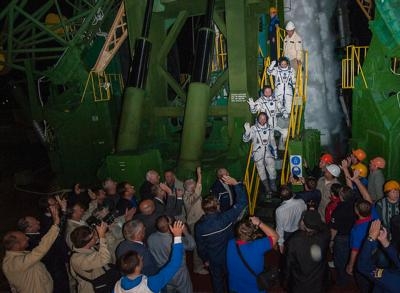Two Russians And An American Join Expedition 41 Aboard ISS
Three crew members representing the United States and Russia headed off to the International Space Station Thursday, launching from the Baikonur Cosmodrome in Kazakhstan at 1625 EDT.

The Soyuz capsule carrying Barry “Butch” Wilmore of NASA and Soyuz Commander Alexander Samokutyaev and Elena Serova of the Russian Federal Space Agency (Roscosmos) was scheduled to dock with the space station about six hours after launch at 2216.
The arrival of Wilmore, Samokutyaev and Serova returns the station's crew complement to six. The three will join Expedition 41 Commander Max Suraev of Roscosmos, Reid Wiseman of NASA and Alexander Gerst of the European Space Agency. They have been aboard the complex since May.
Suraev, Wiseman and Gerst will return home in November. At that time, Wilmore will become commander of the station for Expedition 42. Wilmore, Samokutyaev and Serova will return to Earth in March 2015.
The crew members will be working off the Earth, for the Earth, conducting hundreds of scientific investigations and technology demonstrations during their six-month sojourn on the orbiting laboratory. This research includes seedling growth, observation of meteors entering Earth's atmosphere and studies of animal biology and bone and muscle physiology.
One new study, the Biological Research in Canisters (BRIC) 19, will focus on the growth and development of Arabidopsis thaliana seedlings in microgravity. A. thaliana is a small flowering plant related to cabbage. Researchers hope to gain a better understanding of how the growth responses of plants alter in microgravity. The seedlings will be preserved and returned to the ground for evaluation. BRIC helps to maximize research and minimize space and crew time. The hardware also adds to the collective body of knowledge about basic plant growth phenomena and may help improve growth and biomass production to benefit farming practices on Earth.
Another new space station investigation is the Meteor Composition Determination (Meteor). Meteor will enable the first space-based scientific investigation of meteors as they enter Earth's atmosphere. Meteor uses high-resolution video and image analysis of the atmosphere to ascertain the physical and chemical properties of meteoroid dust, such as size, density and chemical composition. Because scientists can usually identify the parent comets or asteroids for most meteor showers, the study of the meteoroid dust from the space station provides information about the parent comets and asteroids. Investigating the elemental composition of meteors adds to our understanding of how the planets developed, and continuous measurement of meteor interactions with Earth's atmosphere could spot previously unforeseen meteor showers.

Effects of Gravity on Maintenance of Muscle Mass in Zebrafish (Zebrafish Muscle) is an investigation that will observe the effects of microgravity on the zebrafish, Danio rerio, a tropical freshwater fish belonging to the minnow family. The goal of the study is to determine whether zebrafish muscles weaken in microgravity similarly to human muscles and, if so, isolate the cause. Results from the Zebrafish Muscle investigation may help identify molecular changes involved in the deterioration of muscles exposed to microgravity. This data can help scientists develop new treatments for weakened muscles. The findings could potentially benefit patients on extended bed rest or with limited mobility. In addition, this information would aid researchers in developing countermeasures for muscle weakness in astronauts living in microgravity during extended missions.
The new crew members will perform additional experiments that cover human research, biological and physical sciences, technology development and Earth observations, as well as engage in educational activities. The crew will conduct one Russian and as many as three U.S. spacewalks. They will greet two Russian Progress spacecraft resupply flights, the third commercial resupply flight of Orbital Science's Cygnus spacecraft and the fifth and sixth flights of SpaceX's Dragon cargo spacecraft.
The International Space Station is a convergence of science, technology and human innovation that demonstrates new technologies and makes research breakthroughs not possible on Earth. The space station has had continuous human occupation since November 2000. In that time, it has received more than 200 visitors and a variety of international and commercial spacecraft. The space station remains the springboard to NASA's next great leap in exploration.
(Images provided by NASA)
 ANN's Daily Aero-Term (05.29.25): Terminal Radar Service Area
ANN's Daily Aero-Term (05.29.25): Terminal Radar Service Area ANN's Daily Aero-Term (05.30.25): Very High Frequency (VHF)
ANN's Daily Aero-Term (05.30.25): Very High Frequency (VHF) Aero-News: Quote of the Day (05.30.25)
Aero-News: Quote of the Day (05.30.25) Airborne 05.23.25: Global 8000, Qatar B747 Accepted, Aviation Merit Badge
Airborne 05.23.25: Global 8000, Qatar B747 Accepted, Aviation Merit Badge ANN's Daily Aero-Linx (05.30.25)
ANN's Daily Aero-Linx (05.30.25)




